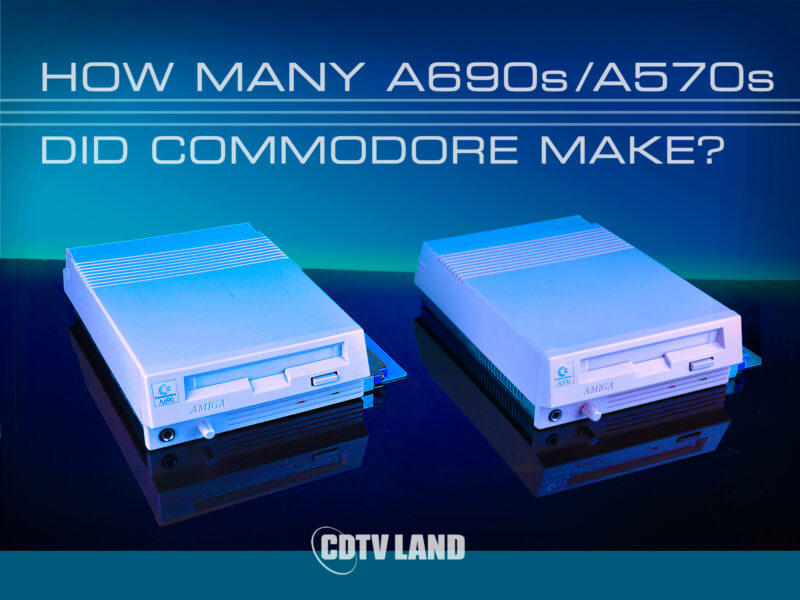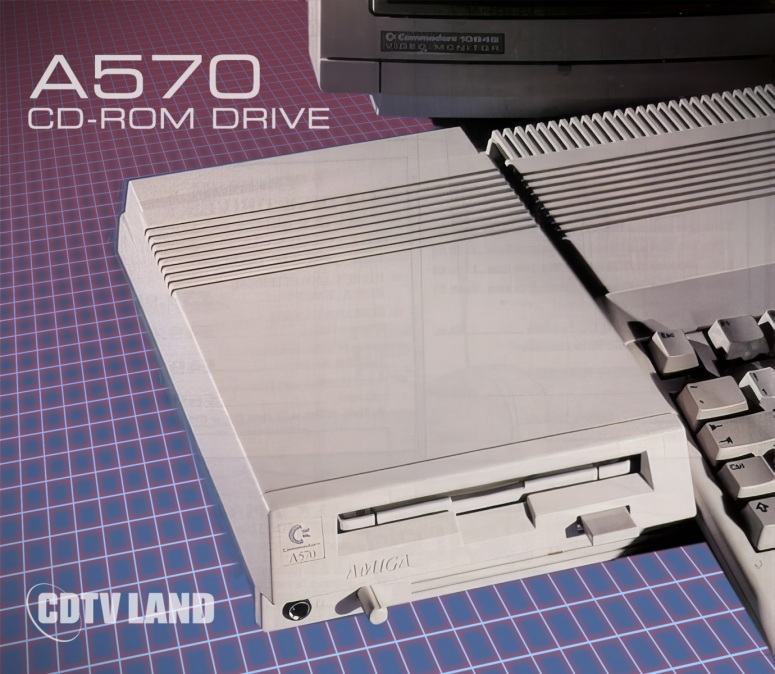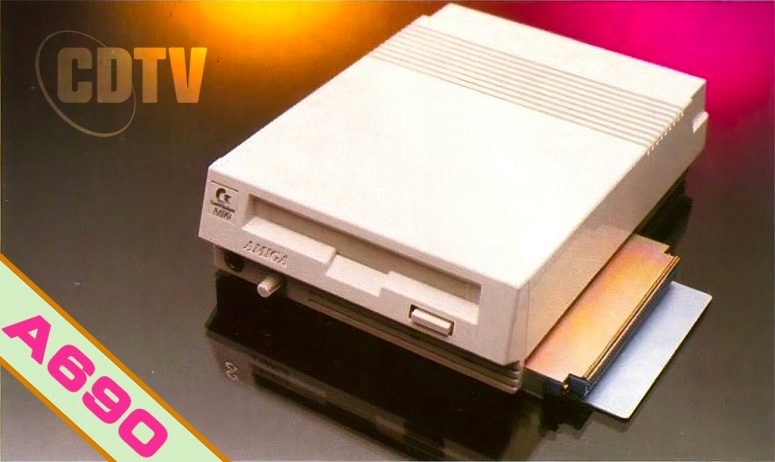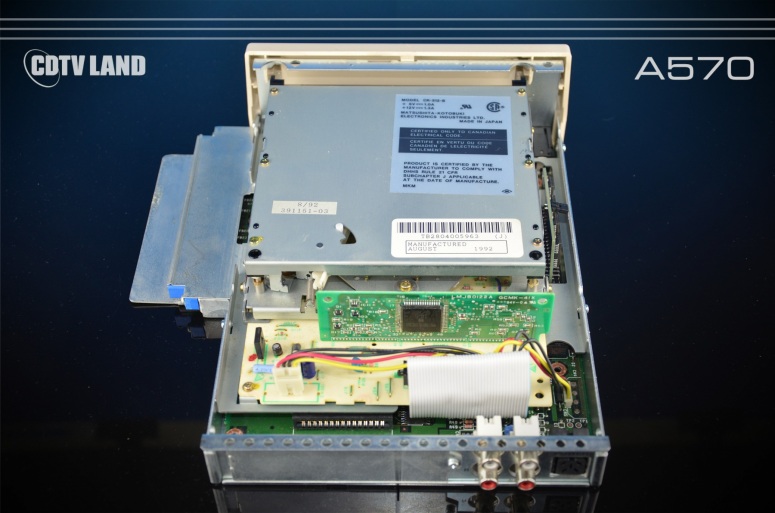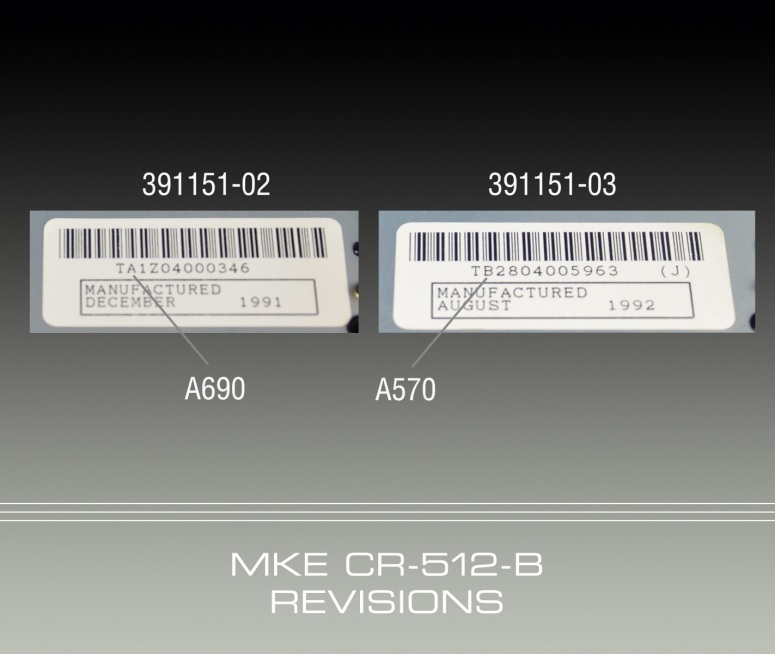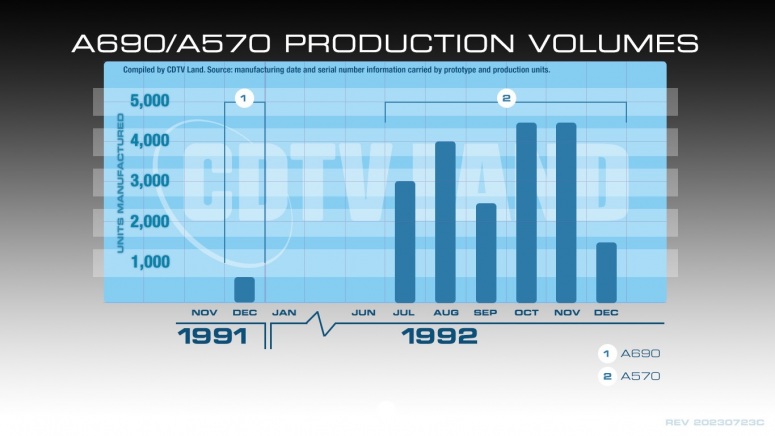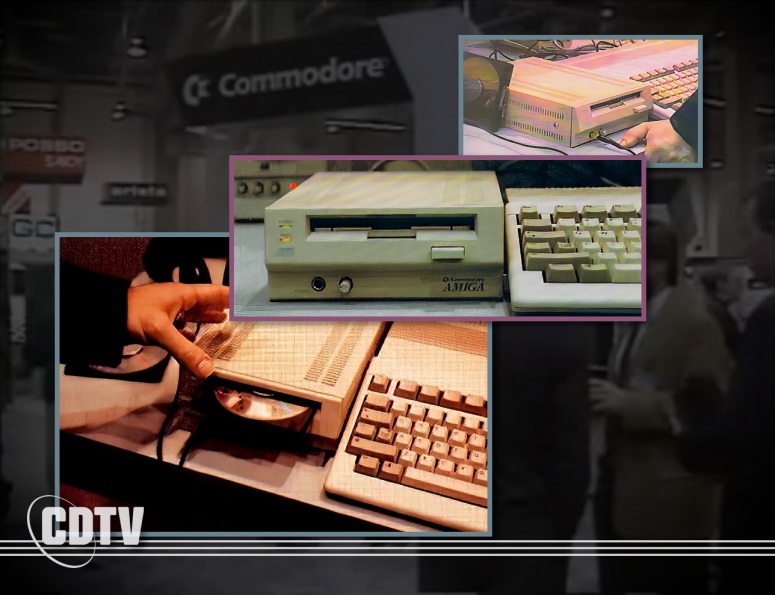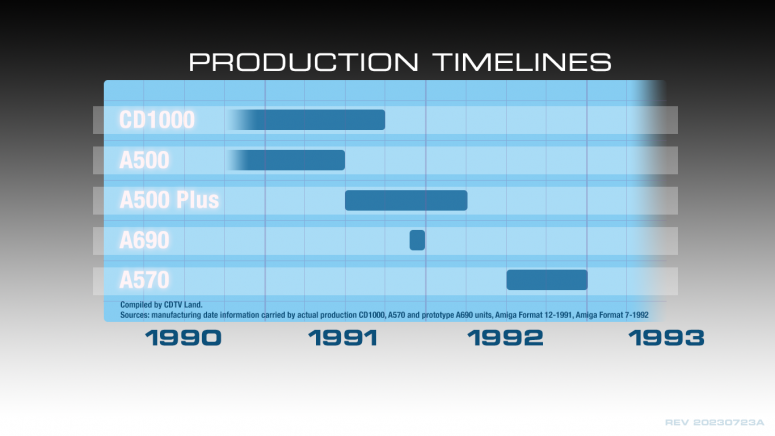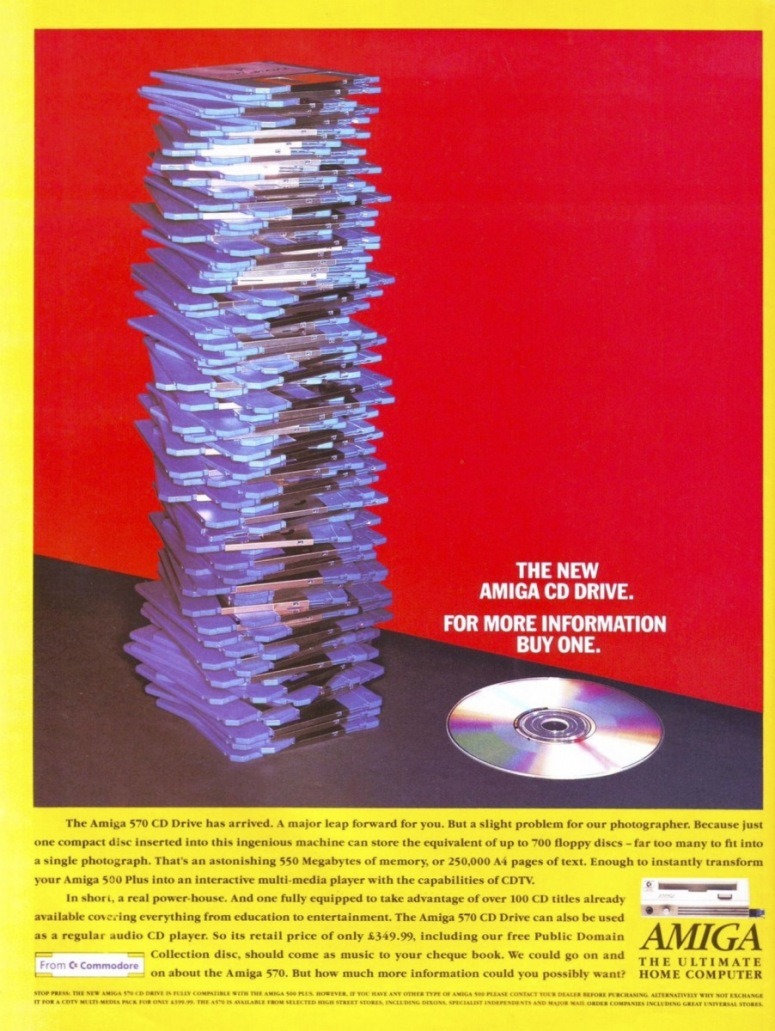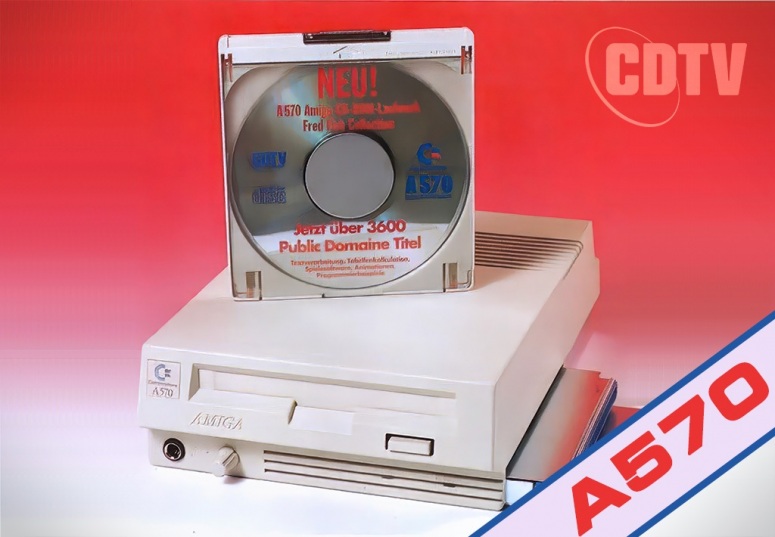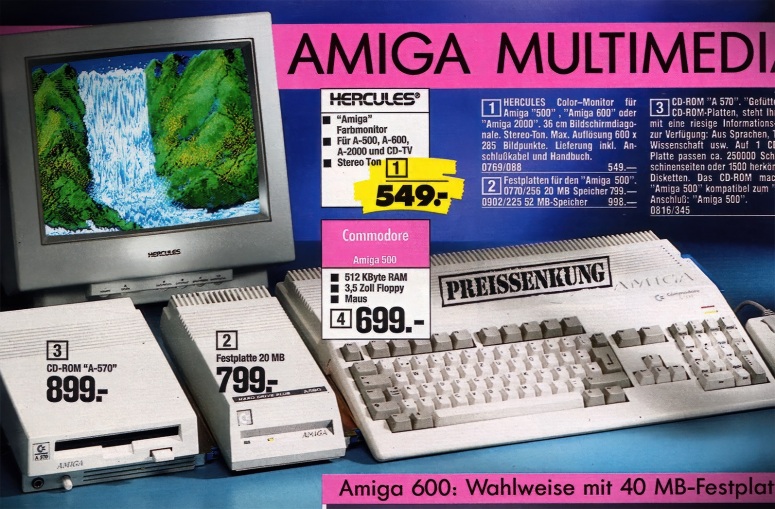
The A570 CD-ROM drive is a fascinating part of Commodore’s legacy, as it is inextricably linked with CDTV: it makes the A500 compatible with CDTV titles. The original CD1000 CDTV player turned out to be an unmitigated disaster for Commodore with approximately just 80,000 units manufactured and Commodore hardly being able to sell them. So how did the A570 fare in comparison, and how many units did Commodore make? And what’s up with that A690 drive? Join me for another excursion into the fascinating world of Commodore’s CDTV history!
Contrary to the CD1000, I am not aware of any quotes or estimates on how many A570 units were manufactured or sold. All there is, is a couple of prognoses on how many units the German and UK Commodore sales subsidiaries expected to be able to sell. In March 1992, a few months before the A570 went into production, a spokesperson for Commodore was quoted at that year’s CeBit show in Hannover, Germany that they expected to sell 50,000 units in Germany alone before the end of the year,[1] while Commodore UK’s Managing Director Kelly Sumner was quoted in July of 1992 that he expected a somewhat more modest 20,000-30,000 units could “comfortably” be sold in the UK before Christmas.[2] They were both wide off the mark…
A570 with A500
DISCLAIMER
As with the CD1000 article I have to preface this with a small disclaimer. The numbers in this article are estimates based on serial numbers and consequently there is a certain margin of error involved. That having been said, I think the numbers here do paint a reasonably accurate picture and they’re probably as good as it gets without access to some official records. My previous estimate of 80,000 CD1000 units turned out to be right on the money, because this number has been confirmed by Don Gilbreath[3], the hardware designer of the CD1000 and member of the Special Projects team that developed the CDTV player. I am using this same method for determining the number of A690 and A570 units manufactured.
Methodology
To estimate the total number of manufactured A690 and A570 CD-ROM drives I am using various (serial number based) data sources. The A690 and A570 do not have the typical yellow mainboard serial number stickers that the CD1000 has, but fortunately the drive assembly (MKE model CR-512-B) does have a manufacturer serial number on it, and it also carries a manufacture date. An additional source of data is the Commodore serial number which is printed on a sticker on both the packaging of the A570 and on the unit itself, which also carries a sequence number and a manufacture date. Finally, the PCB assembly serial on the A690 mainboard and the A690 case serial number are another source of information.
I won’t bore you with the details of how this information is encoded into these seemingly cryptic numbers, but I will dedicate a separate post to this subject in the future for those who are interested. As with the CD1000 (CDTV player) article I will be applying frequentist inference on the observed serial numbers to estimate the total number of produced units, and I will be rounding up or down to the nearest sensible round number. Let’s dive straight in with the A690!
A690
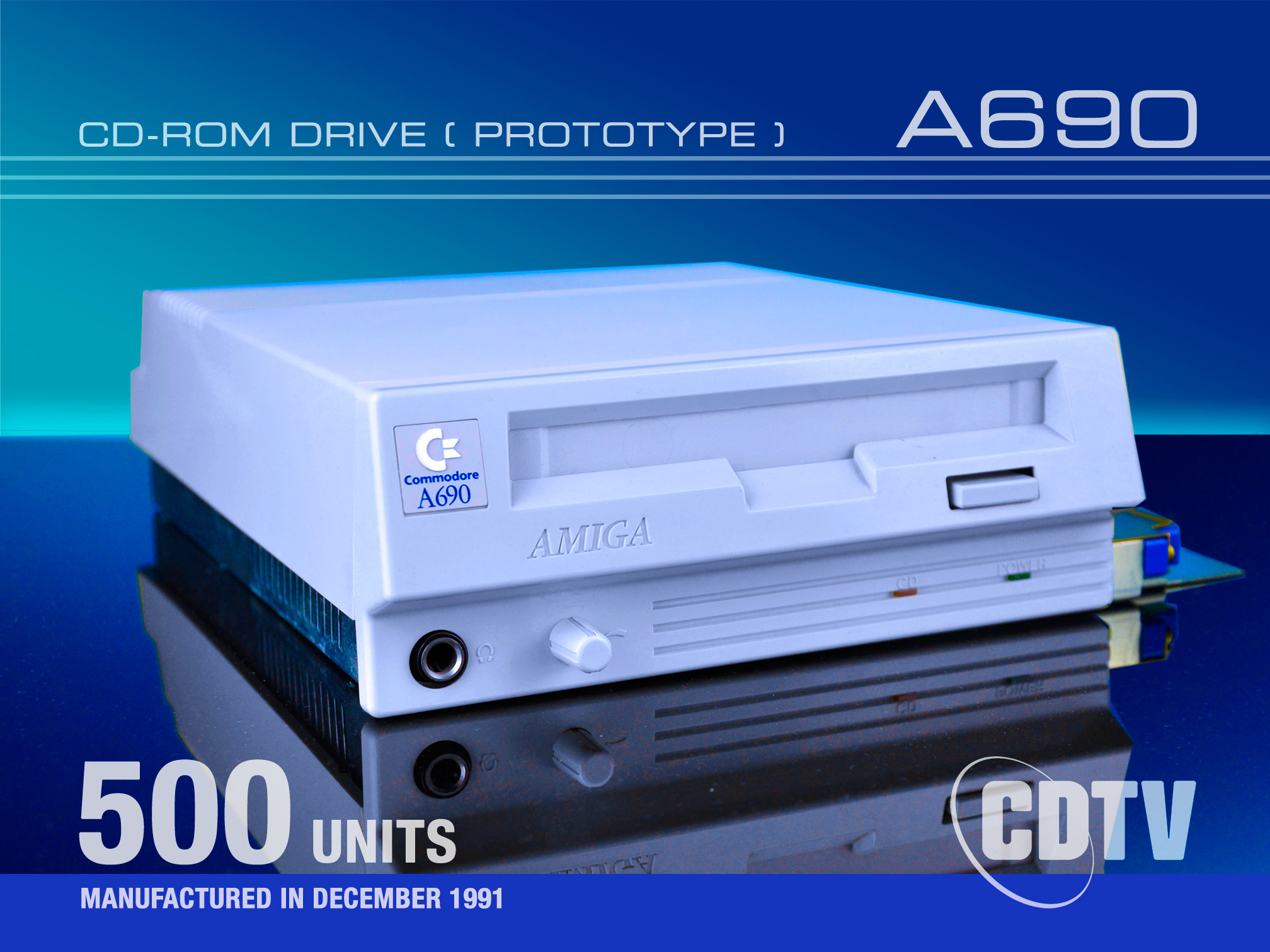
The A690 is a prototype/pre-production unit and was made available by Commodore to registered CDTV developers (although limited quantities did also end up available from Amiga retailers in Denmark in 1992). Based on 16 observed serial numbers I estimate the total number of A690 units manufactured is around 500.[4]
The PCB assemblies all carry a week code of 4891 (which is the last week of November of 1991) and the drive assemblies all have the 4th of December 1991 encoded into their manufacturer serial number. Judging by reports that Commodore UK received their shipment of A690 units before Christmas 1991, to me this pretty much nails the date of final assembly of all A690 units to early to mid-December 1991.[5]
Matsushita of Japan
Just like the CD1000 CDTV player, the A690 drive was manufactured for Commodore by Japanese Matsushita Electric Industrial Co., Ltd (a.k.a Panasonic), which makes sense, because the add-on was developed alongside the CD1000 player and it uses the same proprietary Matsushita CD-ROM bus interface technology. Commodore Electronics Ltd.’s Hong Kong branch is where final assembly and quality control took place,[6] after which the prototypes were shipped out to the various international Commodore sales subsidiaries for internal testing, to serve as demo units at trade shows, and for distribution to registered CDTV developers so they could make sure their CDTV titles would be compatible with the A690 CD-ROM drive.
Matsushita Electric and Panasonic logos
The drive assembly inside the A690 was manufactured by Matsushita Kotobuki Electronics Co., Ltd. (MKE), a former subsidiary of Matsushita/Panasonic. The model number of the MKE CD-ROM drive inside the A690 is CR-512-B (as opposed to CR-511-B in the CD1000). Although the drives are compatible with one another from a software/device driver perspective (the proprietary bus protocol is identical), the physical drive assembly is different between the two models. You can’t simply swap a CR-512-B drive for a CR-511-B or vice versa without modifications (it might be possible to just swap the transport).
A690 drive with top cover removed
Mainboard
The mainboard of the A690 carries revision number 2.2 and contains some components that you will also find inside a CD1000 player: a ROM that contains the CDTV OS (a fairly buggy version 2.0), the DMAC controller chip, the 6525 TriPort chip and 4 kilobytes of battery backed SRAM to store CDTV OS bookmarks. A lot of this extra hardware is needed to make the A690 compatible with CDTV, which unfortunately also made these units a lot more costly to produce for Commodore. The A690 board appears to have an issue with the audio signal routing, judging by the presence of a bunch of bodge wires on the underside of the board around that area.[7]
A690 mainboard – rev. 2.2, and some of its core components[8]
BATTERY BUNKUM
There’s a persistent piece of misinformation about the battery on the A690 mainboard that I would like to debunk, because this myth has undoubtedly contributed to A690 mainboards dying prematurely: The battery inside the A690 is NOT used to power the CDTV OS ROM or anything else of importance inside the A690. You can safely remove the battery. The CDTV operating system code is stored in EPROM and does not need any battery power to retain its contents (Commodore’s hardware engineers weren’t idiots). The battery is only there to power the 4KB of SRAM, which is used to store CDTV bookmark data. (See here for more information on what CDTV bookmarks are). The worst thing that will happen when you remove the battery is that changes to your CDTV Preferences are not saved when you switch off your A500. On the other hand, the worst thing that will happen if you leave this 30+ year old battery inside this rare prototype piece of Commodore history, is that it will start to leak harmful battery acid all over the mainboard and potentially cause irreparable damage to it. If you own an A690 and haven’t removed the battery yet because of this myth, please be assured you can safely remove it.
Prototype or not?
There’s been some confusion about the status of the A690. Was it a prototype or was it available in the shops? It was most definitely a prototype, which is quite evident from the very low run of 500 units alone. However, for reasons unknown, a limited number of A690 units did come up for sale at Amiga retailers in Denmark in early 1992.
A690 CD-ROM drive add-on
The A690 drives were manufactured in December 1991 and apparently rushed out to several international Commodore sales subsidiaries. Commodore Büromaschinen GmbH (Commodore Germany) received at least 50 units which were sent out to registered CDTV developers.[9] Commodore Business Machines (U.K.) Ltd. (Commodore UK) was reported to have received an undisclosed number of A690 units that very same December, just in time before Christmas[5] of which several units were also made available to registered CDTV developers in the UK,[11] and at least one unit was even rebadged as an A570 and sent for review to UK Amiga magazines. (see the “A690 in Disguise” breakout box for more info).
In the early 1990s, Germany and the UK were Commodore’s biggest Amiga markets by any metric, so it’s not so surprising that many A690 units ended up there. But I think it’s a safe assumption that other international Commodore sales subsidiaries would also have received a certain number of A690 units, and although I have not been able to confirm that Commodore Data A/S (Commodore Denmark) received any units, something very peculiar happened in the Danish market, which I suspect Commodore Denmark was responsible for: several A690 drives ended up for sale from at least two major Amiga dealers in early 1992.[12] Here are two ads from the April 1992 issue of Det Nye Computer that advertise the availability of the A690.
A690 drives for sale from Danish Amiga dealers in early 1992
So even though I would primarily classify the A690 as a prototype, and some units even came with a prototype sticker next to the case serial number, it was also available to consumers in Denmark, albeit in very limited numbers and probably from a very limited number of dealers.[13] It’s still a bit of a mystery what happened there, but I suppose that the regulatory approval process for consumer electronics in Denmark was less strict than in the US and the UK, and Commodore Denmark simply saw an opportunity to create some quick revenue by offloading these prototype units to Amiga dealers, even though they were not intended to be sold to consumers. That honor would befall to the A570. Speaking of which….
A570

The A570 was in production between July and December of 1992 and it will come as no surprise that the A570 was also manufactured by Matsushita Electric Industrial Co., Ltd. and that the CD-ROM drive assembly is the same proprietary technology manufactured by Matsushita Kotobuki Electronics Co., Ltd. (MKE). Based on 44 observed case serial numbers I estimate the total number of A570 units to be 20,000.[14] The lowest observed serial number is 317 from week 39 of 1992 (mid-July) and the highest serial number observed is 19,363 from week 49 of 1992 (early December). Although there are no QC or assembly stickers on the A570 mainboard, I think it’s a reasonable presumption that Commodore Hong Kong will have been responsible for final assembly and quality control, as they were for the A690.
A690-CR
The A570 is basically a cost-reduced and improved version of the A690 prototype. It shipped with an updated CDTV OS ROM version (2.30), which includes several bug fixes and also increases compatibility with CDTV titles. The color and finish of the A570 case was updated to match the case of the A500 (the A690 case has a glossy off-white texture which really sticks out next to an A500) and pins were soldered to the CN2 connector on the A570 mainboard for the optional 2 MB system RAM expansion (the A690 has the same CN2 connector, but comes without a pin header). Cost reduction was achieved by replacing the expensive SRAM and battery solution with non-volatile memory (two AT28C16 EEPROMs), and by replacing the 4-pin Molex plug to the drive with a cheaper mini plug. The A570 includes other changes to reduce the number of components to bring down costs, one of which was probably also the CR-512-B drive itself, which came with a new revision.
A570 with top cover removed
Even though the CD-ROM drive model number inside both the A570 and A690 is CR-512-B, the drives are not identical. This is also evident from the drive serial numbers and the Commodore part numbers. The CR-512-B in the A690 has a serial number that starts with TA, while the CR-512-B in the A570 start with TB. Likewise, Commodore’s part number for the CR-512-B has a different revision suffix for each of the drives. The CR-512-B in the A690 has part number 391151-02, while the CR-512-B in the A570 has part number 391151-03.
The different revisions of the CR-512-B drive
WHAT’S IN A NAME
The name change from A690 to A570 has everything to do with the model A600 computer that was also released in 1992. The A600 did not have a Zorro bus, so you couldn’t use the A690 with an A600. The drive was renamed to A570 to prevent confusion in the marketplace and to unequivocally communicate that this was an add-on for the A500 only.

As to why A690 was chosen as a name to begin with: The most likely reason is because the A690 is designed around the same DMAC chip (DMA controller) as the A590 and the A2090 hard disk controllers. In fact, the A570/A690 Autoconfigs with the same Manufacturer and Product IDs as the A590 and A2090 do.[15]
Mainboard
Most of the A570 units come with a 2.5 revision motherboard, although there appears to also have been a 2.4 revision, which has been observed on one of the earliest A570 units. The most noticeable change between the A690’s 2.2 mainboard and the 2.5 mainboard is the omission of the battery and the replacement of the SRAM chips with EEPROM chips.
A570 mainboard – rev. 2.5, and some of its core components
Production Volumes
Production volume for the A690 is not much of a mystery. The whole run of 500 units was done in December of 1991 as we have already determined. For the A570 we can use the case serial numbers as a source of information, because they have a week number encoded in them. I have aggregated the serial numbers into months, because there aren’t enough datapoints to do a breakdown on a weekly basis.
Production volumes of A690 and A570
Analysis
With just 20,000 units manufactured, that makes the A570 a lot rarer than the model CD1000 player and, judging by the brutal price slashing, Commodore had serious problems selling even this relatively low amount of units, which begs the question: How did things go so wrong, so fast? I think the answer to that question becomes apparent if we look at the circumstances under which the A570 was released, because Commodore managed to doom this product to failure even before it was released (as they would often do)..
On January 10th, 1991 Commodore made a big splash during the Chicago Winter CES (Consumer Electronics Show) and made headlines with their introduction of CDTV. While the aesthetically pleasing model CD1000 CDTV player understandably stole the show, it may come as a surprise to some that a very early prototype of the A690/A570 was already on display at that very same CES. Although this early prototype unit does not carry any model number on its fascia, it was tentatively dubbed A690 according to press reports. The early prototype was seen running a pre-release version of the CDTV operating system[16] and clearly illustrates that the A690/A570 was already in development since at least 1990, in tandem with the CD1000 player.
CDTV/CD-ROM add-on early prototype for the A500
“The A570 added compatibility with a dead platform to a computer model that wasn’t being manufactured anymore.”
Due to challenges during its development, combined with an overly optimistic estimation of how much time was required to be able to go to market with the product,[17] the A570 suffered multiple delays before it was finally released, but by then the landscape had changed dramatically. By the time the A570 finally limped into stores in the fall of 1992, Commodore had A) internally effectively already discontinued CDTV due to disastrous sales, by firing key CDTV personnel and stopping development of the cost-reduced CD500 CDTV player,[18] [19] and -in a move that completely baffled both friend and foe- B) discontinued their still very popular A500/A500 Plus computer,[20] the very computer the A570 was designed for. The A570 was therefor released as a first party product that:
- added compatibility with a dead platform (CDTV)
- to a computer model that wasn’t being manufactured anymore (A500)
Production of A570 starts well after the A500 is discontinued
The apparent incompetence and lack of long term vision from Commodore’s leadership is simply astounding. But wait, it gets worse! To top this all off, Commodore introduced the A570 for the recommended retail price of a hefty 349 GPB in the UK (899 DM in Germany), which was more expensive than the A500 itself by a significant margin.[21] The poor A570 didn’t stand a chance.
PR Spin
Successful international Commodore sales subsidiaries like Commodore UK were left holding the bag and were placed in the unenviable position of having to explain this lunacy to the British Amiga press. Commodore UK’s Managing Director at the time, Kelly Sumner, had a hard time keeping up the usual charade that Commodore UK was more than a glorified sales subsidiary[22] and stumbled his way through an interview with Amiga Format trying his best to give it a positive spin, which is especially cringeworthy looking back. Trying to justify the release of the A570 for the discontinued A500/A500 Plus he stated “This is really designed for the 1.3 owners and there’s something like 500-600.000 of them, so if only 10 per cent upgrade that’s 60.000.”
Kelly Sumner – Commodore UK Managing Director (1992-1993)
When asked if the A670, a CD-ROM drive add-on for the newly released A600, was forthcoming, he expected it by the end of the year, adding “The hard work is done: all we have to do now is change the edge connector for a PC bus connector”, which is a remarkable statement, because replacing the Zorro bus of the A570 with a PCMCIA based interface is anything but trivial, as it would require major changes to the hardware design as well as the necessary device drivers. (The A670 would never appear and was apparently never even in development.)
THE FABLED A670
The A670 is mentioned briefly in an internal Commodore memo, dated June 26, 1992 by Commodore product manager Bill Sydnes, who is single handedly responsible for killing off the still successfully selling A500 to bolster sales of the inferior A600.[23] The memo was addressed to all General Managers of the international Commodore sales subsidiaries to “educate” them (and their dealers) on why the A600 was so superior and why the A500 was stupid, and why everybody should stop complaining and everybody except Bill Sydnes was wrong.[24] The core message of the memo is that the A600 is better, because it has a PCMCIA port, and Sydnes proceeds to list a whole bunch of PCMCIA products (that do not exist yet) to support his claim. One of these is the A670…

Commodore then decided not to create PCMCIA products for the A600 after all [25] and were effectively left with no first party CD-ROM drive product available for any of their current Amiga models that were still in production.
Compatibility Issues
But those were not the only challenges that the A570 and, by extension, the Commodore sales subsidiaries were facing. What might undoubtedly have looked like a very good idea on paper back when the CD1000 was being developed (create a CDTV add-on for the A500 to increase the CDTV install base), quickly fell prey to the intricacies of reality, because the A570 has serious compatibility issues with CDTV titles when paired with an A500. Many CDTV titles that had been developed up until that point targeted the memory configuration specs of the CD1000 player, which is 1 MB of Chip RAM.[26] Although the A500 Plus did come with 1 MB of Chip RAM, that model was only on the market for less than a year and constitutes just a tiny percentage of the overall A500 series install base worldwide. The overwhelming majority of machines in the field were A500s and they typically had only 512KB of Chip RAM and maybe an extra 512KB of pseudo-Fast RAM (a.k.a. slow RAM). As a consequence many CDTV titles would not work on the A570 unless the user had their A500 upgraded to 1 MB Chip RAM, which often involved replacing non-user serviceable parts.
The A570 must have been a nightmare for both the marketing and sales departments: Commodore UK added stickers to the A570 packaging warning users of the fact that it’s really only fully CDTV compatible with the Amiga 500 Plus and encouraging A500 owners to consult their dealer before purchasing one or to swap their A500 for a discount on a CD1000 (which coincidentally had the reverse issue of being less compatible with normal Amiga software written for the A500). Meanwhile, it seems our North American cousins got a much better deal, because the sales subsidiaries over there were actually selling the A570 together with a free 1 MB fatter Agnus upgrade that allowed users to make their A500 fully CDTV compatible.
A570 ad from a US Amiga dealer – Amiga World (Dec 1992 issue)
Amiga CD Drive
With all these CDTV compatibility issues going on, it’s no wonder that Commodore UK’s October 1992 full page ad campaign for the A570 only mentions CDTV compatibility in passing in the fine print (and the compatibility issues in even finer print). Instead of attaching the stigma of CDTV, the product is simply referred to as “The New Amiga CD Drive” and its key selling point seems to be the enormous amount of data that fits on a CD-ROM compared to a floppy disk.
A570 ad from Commodore UK – (October 1992)
Why?
So why did Commodore bother with releasing the A570 at all this point? Why release a product for a platform you’ve already killed off, for a computer model you’re not making anymore? Bear in mind that this is pure conjecture on my part, but I wouldn’t be surprised if Commodore was just fulfilling some sort of contractual obligation with either the manufacturer Matsushita or with mail order companies (or even a combination of both).
A570 retail release in Germany (includes Fred Fish PD disc)
It’s not uncommon for manufacturers to negotiate a minimum order quantity with their customers, so that they know they will at least recoup some of their investment in the development of the product in question. The A570 wasn’t just some off-the-shelf product Matsushita had lying around. Even though core components of their CD-ROM technology were undoubtedly already in place, a significant chunk of this product was developed specifically for and together with Commodore, ostensibly under the expectation that if this whole CDTV multimedia revolution were to take off, they would receive many additional orders.[27]
Likewise, I think it’s quite possible that Commodore was just fulfilling contractual obligations with mail order companies that they had committed to. In the 20th century, mail order catalogs would typically appear twice a year (e.g. a spring and fall catalog) and if a mail order company agrees to carry a specific product in one of their catalogs, it was not uncommon for them to negotiate some type of delivery guarantee from their supplier for the duration of the catalog’s availability.
A570 listed in a Neckermann mail order catalog ’92/’93
A690 IN DISGUISE
The A570 did not go into production until July 1992 and appeared at retail months later. To be able to provide advance units to the Amiga magazines or mail order companies for product photography purposes Commodore rebadged A690 units as A570 units. Here’s how to recognize a rebadged A690:

1. The badge is different or “off” compared to proper A570 badge, variations exist
2. The volume knob has less of an angle, is almost straight, compared to the wider angled A570 volume knob
3. The color of the metal plate on top of the Zorro connector is gold(ish), while the A570 is silver
4. The case is glossy/reflective
5. The case is off-white, really noticeable next to an A500
6. The Audio In/Outs are swapped and have stickers to cover up the manufacturing error
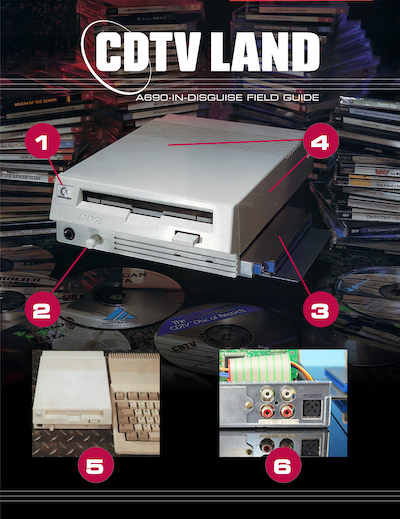
A690s in disguise have been spotted in CU Amiga, The One Magazine, Amiga World, and the German Neckerman 92/93 catalog. Can you find more?
In Conclusion
The A570’s story is an intriguing one. It exemplifies Commodore’s weirdness and uniqueness as a computer manufacturer (and that’s putting it euphemistically.. it’s really a miracle the A570 ever got released), and learning about its history has only increased my appreciation for this device. As with the CD1000 player, Commodore was a trailblazer and was one of the first companies to bring a (relatively) affordable CD-ROM drive to consumers. But, in another parallel with the CD1000, they completely botched the execution which ended up costing the company dearly and will have undoubtedly contributed to its downfall which occurred barely two years later. The A570 was not a cheap product to manufacture for Commodore. The MKE CR-512-B drive was an expensive component and CDTV OS compatibility required many additional parts to be integrated into the mainboard which increased development time and added to the bill of materials. The prices that the A570 was being sold for not long after its introduction were definitely below cost price.
A570 with caddy
With all the missteps and the fumbled introduction to the market, you would almost forget that the A570 is a very nice and capable piece of hardware. It was a great little expansion for the aging A500, especially at the rock bottom prices it was being sold for a year after its release (99 GBP and lower), featuring CD Audio playback and ISO9660 CD-ROM support. At that point in time (1993) CD-ROM drives for PC or Mac were still 5 to 7 times more expensive than what you’d pay for a discounted A570,[28] so the A570 represented incredible value for money at that price point. The various Public Domain CD-ROM CDTV titles (which generally worked fine with A500s and were typically bundled with the A570) were often worth the price of admission alone to many an Amiga fan, and thanks to its ISO 9660 standard support it could even read data files from PC CD-ROMs.
New Life
Just like the A600 which was released around the same time, the much maligned A570 CD-ROM drive is a perfect example in my book of a piece of tech that bombed in the market place way back when it was released, was almost universally looked down upon, but decades later redeemed itself when it was rediscovered by retro computing enthusiasts and judged on its own merits instead of the context within which it was released in 1992.
A570 + 17-Bit PD CD-ROM + beer = bliss!
In the 21st century the A570 is still a great companion to a basic A500. If you populate the A570 with the optional internal 2 MB RAM expansion you can literally burn hundreds of games or demos to a CD+R and use it as a WHDLoad machine, but you can also explore the vast amount of CDTV titles and Amiga CD-ROMs in a period authentic style. Another thing you can do of course is hook it up to your amplifier and listen to Audio CDs, which is increasingly becoming a retro pastime for many people. (I suddenly feel very old writing this)
Listening to CD audio using an A570
But the A570 is not limited to unexpanded A500s anymore! The release of the custom CDTV OS 2.35 upgrade has given the A570 a new lease on life, because it finally fixes the compatibility issues the drive had with 68030 accelerators and 32-bit Fast RAM. A500 owners no longer have to strip their computer down to its stock configuration just to use an A570. And with CDTV Land’s commitment to continue supporting the A570 and the A690 with future custom CDTV OS updates (and with as of yet unannounced projects!), there really hasn’t been a better time to own an A570.
So, here’s to the A570. Long may it continue to function! 🙂
Footnotes
- Source: “CDTV Push at CeBit” – Amiga Computing magazine – May 1992 issue ↩
- Source: “A570 CD-ROM drive goes on sale at 349” – Amiga Format magazine – September 1992 issue ↩
- Source: Don Gilbreath in “Commodore: The Final Years” – Brian Bagnall ↩
- 5 observed A690 MKE CR-512-B serial numbers (103 lowest, 492 highest), 6 A690 PCB assembly serial numbers (6 lowest, 429 highest) and 4 serial number stickers on the underside of A690 units (121 lowest, 353 highest) ↩
- “Commodore UK received a number of prototypes of the A690 before Christmas”. Source: “A690 set to go on sale in March” – Amiga Format – March 1991 issue ↩
- Source: QC/assembly sticker on A690 mainboards ↩
- The audio ins and outs on the A690 are swapped, i.e. the other way around compared to the A570. As a result, the A690 has a sticker on the back under the RCA inputs to fix the incorrect factory print on the unit. ↩
- From my personal collection. Don’t worry, the battery has been removed 😉 ↩
- Source: “Aktuell – Messebericht” – Amiga Magazin – April 1992 issue ↩
- “Commodore UK received a number of prototypes of the A690 before Christmas”. Source: “A690 set to go on sale in March” – Amiga Format – March 1991 issue ↩
- “Developers have already started taking delivery of A690 drives for the A500”. Source: “Schizophrenic add-on” – Amiga Computing – May 1992 issue ↩
- A690 drives were available from dealer Betafon in Copenhagen and Amiga Warehouse in Aarhus, Denmark. ↩
- I was able to track down a contact from Betafon who was responsible for Amiga products and possibly even for this particular advertisement, and while they confirmed Betafon typically got their Commodore products from the official sales subsidiary Commodore Data A/S (Commodore Denmark), in some cases they would also obtain product from other sources (e.g. using parallel import, as many other dealers would also do) and, due to so much time having passed, they could not confirm with certainty anymore that Commodore Denmark was the actual source of the A690 units they had for sale in 1992. I have been unsuccessful as of yet in tracking down anyone related to the dealer from the other ad, Amiga Warehouse. ↩
- A570 case serial numbers are the most common to observe, because they do not require opening up the unit. However, the secondary source of serial numbers that I have, which is the CR-512-B drive’s manufacturer serial number, corroborates the estimation of 20,000 units. ↩
- The DMAC is actually the component that is responsible for the Autoconfig process. That is why it is impossible to detect whether the device is an A590, A2090, A690 or A570 purely based on the Autoconfig Product ID 514. ↩
- Source: “Das große CD-Special” – Amiga Joker magazine – June 1991 issue ↩
- Source: Commodore engineer Hedley Davis in “Commodore: The Final Years” – Brian Bagnall ↩
- Commodore’s CEO Mehdi Ali had laid off all CDTV staff by August 1992. Source: “Commodore: The Final Years” – Brian Bagnall ↩
- Source: Accountant and later joint Commodore UK Managing Director Colin Proudfoot in “Commodore: The Final Years” – Brian Bagnall. ↩
- Source: “End of the line for A500” – Amiga Shopper – July 1992 issue ↩
- Around the time that the A570 was released, the A500 supply that was either still available in the distribution channel or was still being manufactured in low volumes to meet contractual obligations, was available for a RRP of around 299 GBP in the UK, and 699 DM in Germany ↩
- Virtually all the decision making regarding the development and production of hardware was done by the parent company Commodore Electronics, Ltd and the US subsidiary Commodore Business Machines, Inc. Like most of the other international subsidiaries, Commodore UK was primarily a marketing and sales operation and, with the exception of their Corby plant assembly line in 1984-1986, they were seldomly involved in the development of hardware or manufacturing of products. They have a history of being blindsided by their parent company with new products, whether they asked for them or not: the A500 Plus, its subsequent discontinuation, and the A600 being prime examples. ↩
- Source: Commodore engineers Hedley Davis and Dave Haynie in “Commodore: The Final Years” – Brian Bagnall ↩
- Bill Sydnes has a history of being involved with fiascos. While he previously worked at IBM he was involved with the PCjr project, which is one IBM’s most embarassing failures. ↩
- Source: Commodore Germany employee Rainer Benda in “Untergang von Commodore” – Rainer Benda ↩
- The CDTV developers were probably not the ones to blame here, as they would have been developing titles based on specs and early CDTV units provided by Commodore. ↩
- Mastushita did continue to develop their MKE CD-ROM drive technology beyond CDTV, and started releasing CD-ROM drives for PC both under their Panasonic and Matsushita brands, but also as OEM units. They would continue to release drives with their proprietary MKE bus, but also drives based on standardized buses like SCSI and later IDE. The model numbers for these drives are all in the ranges of CR-52x, CR-53x and higher. I don’t know of any other drives in the CR-51x range, except for the CR-511-B and CR-512-B drives and I don’t know of any other product that featured these drives, so it looks like they were really purpose-built and/or customized for Commodore’s CDTV line of products. ↩
- Source: “Old PC Prices” ↩

